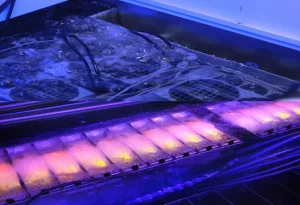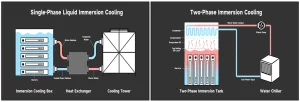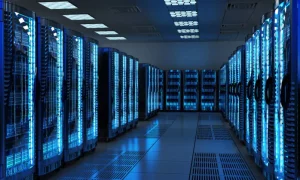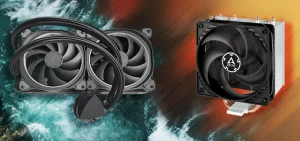
In recognition of the fact that the power supplies used in computers have a 1:1 heat-to-electricity ratio, Box Technology invented a way to cool computer components by immersing them in dielectric fluid. If you’ve ever jumped into the water during the summer heat, you understand that immersion cooling is a wonderful way to cool down. Interest in the technology has grown as technology has advanced. But what is immersion cooling?
Immersion cooling involves submerging system components in water. This includes the motherboard and other computer components in a dielectric liquid. The procedure requires the use of fluids that will not harm the IT components. Immersion cooling saves energy and space. Oils and designed fluids, such as 3M’s Novec or Fluorinert series, are the two types of dielectric fluids currently used for immersion cooling. In today’s article, let’s take a look at two types of immersion cooling: single-phase immersion cooling vs two-phase immersion cooling.
Single-Phase Immersion Cooling VS Two-Phase Immersion Cooling
In the picture below, let’s learn the difference between single-phase immersion cooling and two-phase immersion cooling.

One technology is Single-Phase Liquid Cooling. In single-phase immersion cooling, liquids maintain their liquid form throughout the cooling process and increase in temperature as they remove heat from the heat-generating equipment.
The other is Two-Phase Immersion Cooling. In two-phase immersion cooling, the coolant changes its state of matter. When the heat-transferring liquid is heated to its boiling point, heat is removed through latent heat transfer; the liquid is converted to gas rather than raising the temperature of the surrounding coolant.
Similar to single-phase systems, two-phase ones use dielectric fluids. The difference between these two systems is what happens to the substance. In a two-phase system, the liquid starts as a liquid and then becomes gaseous. This phenomenon is known as latent heat. This is when heat (thermal energy) is needed to change the phase of the fluid. The fluid is cooled by boiling and the energy is transferred to the vapor.

In summary, data centers are undergoing many changes. As processor performance continues to increase, equipment and servers will require more efficient and intuitive systems to achieve the expected growth rates.
Fortunately, a number of liquid cooling solutions are available to help growing businesses bridge this gap between supply and demand. As the trend toward sustainability sweeps across the computing market, liquid cooling solutions help businesses with high levels of waste. In short, liquid cooling solutions offer promising solutions to address changes in the data center market.
At Box Technology, we don’t claim that one technology is better than another. However, we believe that our expertise and years of experience combine to put us in a unique position to design solutions. These solutions are specifically designed to truly solve the real problems facing companies, using forward-thinking, innovative technology.
Our solutions take the fundamentals of single-phase immersion cooling and take it to the next level by eliminating the shortcomings of two-phase immersion cooling. All of this is sustainable, environmentally friendly, and extremely cost-effective. Don’t just take our one-sided statement, contact us today and see for yourself.



